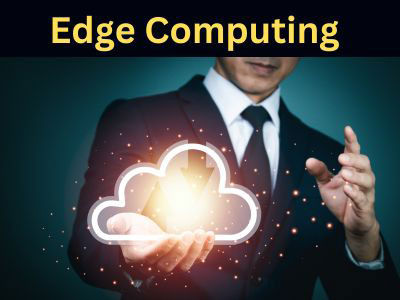Key Takeaway
Edge computing and cloud computing both deal with data processing but in different ways. Edge computing processes data closer to the source, at the “edge” of the network, reducing latency and improving speed. It’s ideal for real-time applications, like autonomous vehicles or smart devices, that require quick decisions.
On the other hand, cloud computing relies on centralized data centers to process and store data. It offers powerful computing resources and scalability but can be slower due to the distance data must travel. While edge computing focuses on speed and local processing, cloud computing is better suited for tasks that require large-scale processing and storage. Both play key roles, with edge computing handling immediate tasks and cloud computing managing more complex, long-term processing.
Definitions and Core Differences Between Edge and Cloud Computing
Edge computing and cloud computing are often compared, but they serve different purposes. Cloud computing centralizes data processing in remote data centers, allowing users to access vast computational power and storage capabilities over the internet. While this setup is ideal for large-scale data analytics, cloud computing can suffer from latency issues. When you send large amounts of data to the cloud, there’s a delay due to the distance between the device and the data center.
On the other hand, edge computing decentralizes this process by moving the computation closer to the data source. This means data is processed locally on devices or at nearby edge servers, which significantly reduces latency. Edge computing thrives in environments where real-time data processing is essential, such as in autonomous vehicles or IoT devices. The primary distinction is that cloud computing offers scalability and powerful processing capabilities, while edge computing focuses on speed and efficiency by reducing reliance on distant servers.

Comparing Processing Power and Latency in Edge vs. Cloud
When you think about processing power, consider where it happens. Edge computing processes data closer to where it’s created—think sensors or smart devices—while cloud computing relies on far-off data centers. This difference shapes how quickly decisions can be made.
Imagine a factory monitoring a production line. If there’s a delay in response due to cloud processing, machines could falter. In contrast, edge computing can analyze data on-site in real-time, enhancing efficiency. Latency, or response time, is crucial in applications like autonomous vehicles or healthcare devices, where every second counts.
The speed of edge solutions vastly outperforms cloud counterparts for many applications. It’s like playing on a local network instead of over the internet; the connection is tighter, the responses quicker. For new engineers, understanding this distinction is vital. Picking the right approach ensures that your projects meet performance expectations and deliver the best results.
With advancements in technology, the lines between edge and cloud are blurring. However, knowing when to utilize each is an essential skill for any engineer. Start by assessing the nature of your application and the importance of processing speed in achieving optimal performance.
You May Like to Read
Use Cases Best Suited for Edge Computing
Edge computing shines in scenarios where real-time data processing is essential. Here are some top use cases:
Autonomous Vehicles: Real-time decision-making is critical for navigation, obstacle detection, and safety systems. Edge computing ensures immediate data processing without relying on external networks.
Smart Cities: Traffic management systems, surveillance, and energy monitoring rely on edge devices for quick, localized decisions.
Industrial IoT (IIoT): Factories use edge devices for predictive maintenance, quality control, and machinery monitoring, reducing downtime and improving efficiency.
Healthcare: Wearable devices like fitness trackers and glucose monitors process data locally to provide instant feedback, enhancing user experience.
These applications highlight edge computing’s ability to deliver low-latency responses, making it indispensable in critical scenarios.
Use Cases Best Suited for Cloud Computing
Cloud computing is indispensable for applications requiring extensive storage, scalability, and computational power. Key use cases include:
Data Analytics: Businesses rely on cloud systems to analyze vast amounts of data, providing insights that drive decision-making.
Software as a Service (SaaS): Platforms like Google Workspace and Salesforce operate on cloud infrastructure, offering seamless access to tools and services.
E-commerce: Online retailers use cloud computing to manage inventory, process transactions, and handle high traffic during peak seasons.
Artificial Intelligence (AI): Training complex AI models demands immense computational resources, making cloud computing the ideal choice.
With its unmatched scalability and power, cloud computing is a cornerstone for modern, data-driven applications.
How Edge and Cloud Can Work Together
Edge and cloud computing are not mutually exclusive; they complement each other beautifully. Many systems adopt a hybrid approach to leverage the strengths of both technologies.
For example, edge devices can process critical data locally to ensure immediate responses. Simultaneously, non-urgent data is sent to the cloud for advanced analytics, storage, and decision-making. This synergy enhances overall system performance while optimizing costs and resources.
In retail, edge devices manage in-store operations like inventory tracking and payment processing. Meanwhile, cloud systems analyze customer data to forecast trends and personalize marketing. This collaborative approach is increasingly becoming the standard across industries.
Conclusion
Choosing between edge and cloud computing depends on your specific needs. If real-time processing and low latency are priorities, edge computing is the answer. For scalability, storage, and heavy-duty computation, cloud computing is indispensable.
By understanding their differences and use cases, businesses can adopt a hybrid strategy that maximizes the potential of both technologies, ensuring efficiency, scalability, and innovation.
